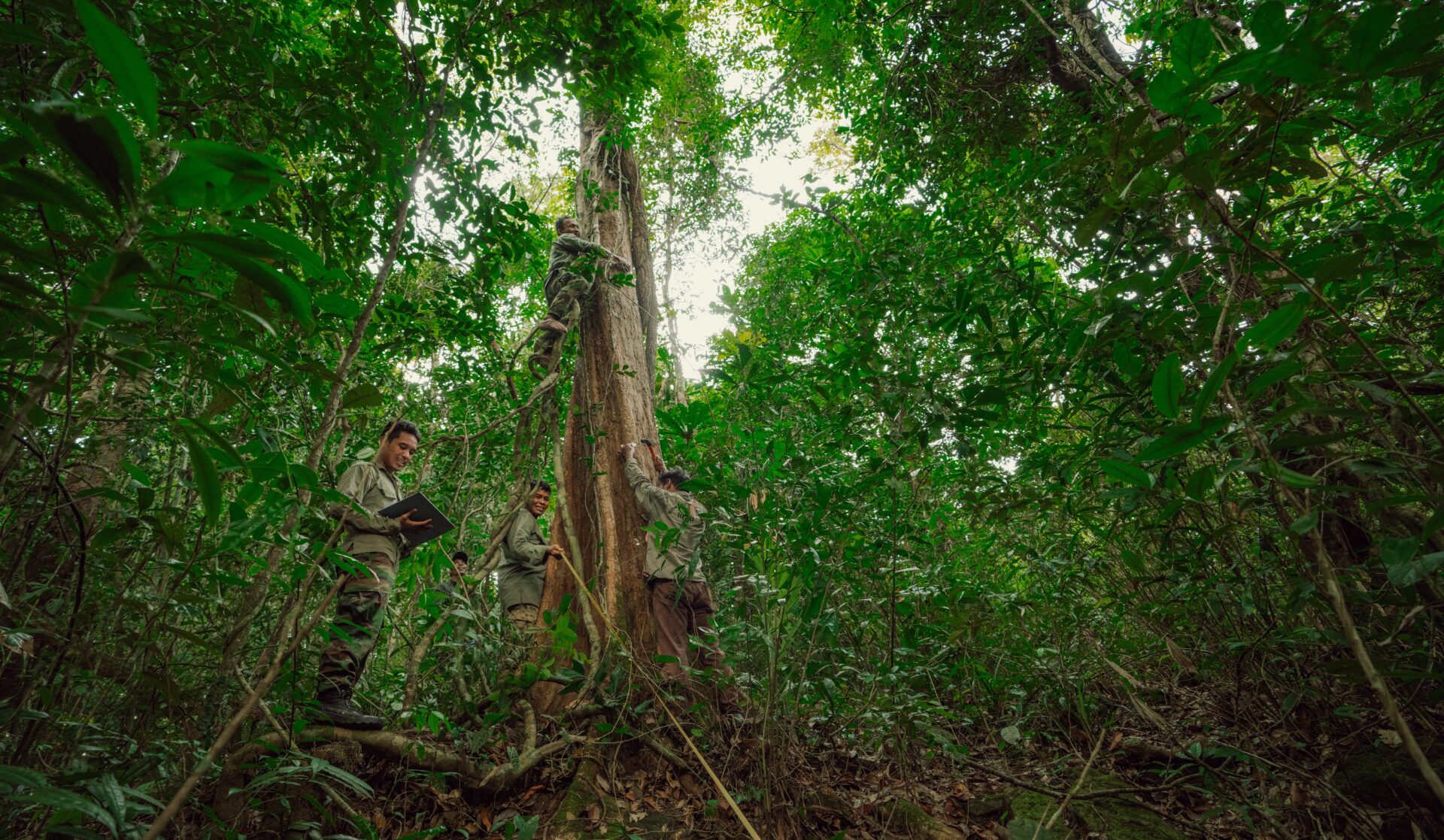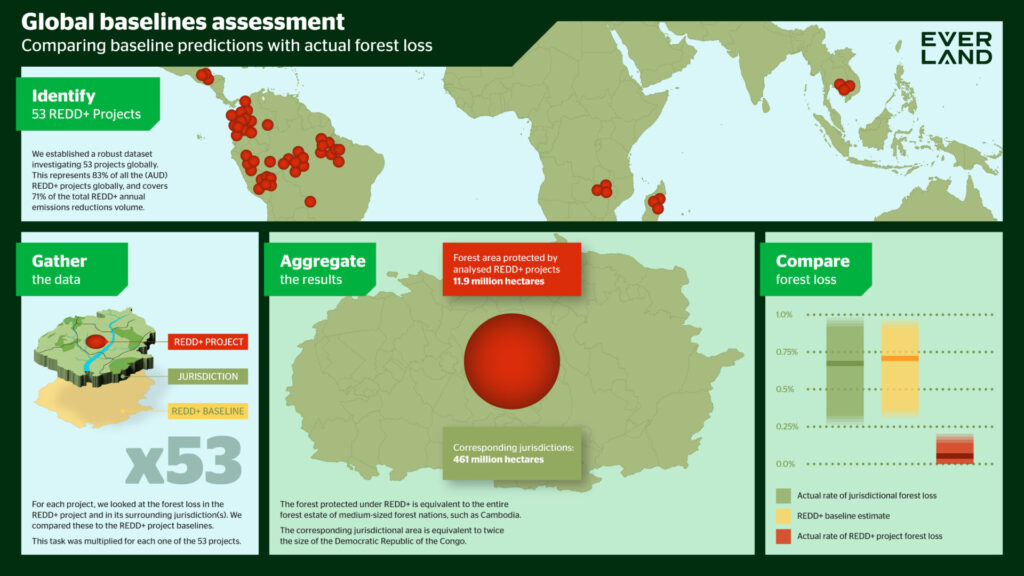
In this new research, we find:

Study scope
We have completed a global study of 53 REDD+ projects across 7 countries, in which we compared REDD+ project baselines against the actual forest loss that has taken place in the state containing the project. In total, the analyzed projects generate an average of 34.6 million tCO2e/year of emissions reductions and cover 11.8 million hectares of forest – representing 83% of Verra VCS-registered Avoided Unplanned Deforestation (AUD) REDD+ projects by area and 71% by annual emissions reductions volume – the majority of REDD+ credits ever sold.
Our methodology
For this study, we compared the predicted forest loss rates of REDD+ baseline scenarios with the actual forest loss rates observed in the jurisdictions surrounding the REDD+ projects (i.e., the state or region containing the project). Given the socioeconomic complexity of forest loss drivers, there is substantial spatial variability in the way that the forest loss threats in a landscape manifest as actual forest loss in a particular place. In any small-scale control area forest loss may occur faster or slower than may be expected given the threat level present in the broader landscape. Our approach recognizes that for avoided unplanned forest loss scenarios, there is no perfect “control” against which to assess the reasonableness of a baseline scenario in hindsight.
This is why considering forest loss in the wider landscape is important: The jurisdiction surrounding a project operates under similar ecological and socio-economic conditions, and therefore provides a broader, robust basis of comparison to assess how much forest loss would have occurred in the “without-project” scenario. Our approach addresses key methodological problems of other baseline studies (see below), while utilizing the same satellite series as the principal study cited in a recent Guardian article.1
The tricky science of assessing baselines
Broadly, the aim of REDD+ baseline research is to assess in hindsight, the reasonableness of the without-project “business-as-usual” (BAU) forest loss scenarios against which REDD+ projects aim to perform, in light of the forest loss that has actually happened in a comparison area. Evaluating the accuracy of a counterfactual forest loss scenario is inherently uncertain given the highly complex socioeconomic and environmental systems at play. Fundamentally it is impossible to “validate” a counterfactual simply because by definition it is what did not happen. While there are many potential techniques, data sets, and methods that can be used to evaluate baseline counterfactual scenarios in hindsight, there is no generally accepted scientific standard or approach.
One particular approach, the “synthetic control” method applied by West et al.,2,3 has garnered substantial media attention; however, analysts have identified serious methodological flaws4-7 including:
These issues call into question the sweeping conclusions about REDD+ baselines that have been made by the authors, and the media articles that have popularized their findings.

Conclusions
Our analysis shows that REDD+ baseline predictions, integrated across the substantial majority of Verra VCS AUD projects over a twenty-year period, have corresponded remarkably accurately with observed forest loss rates in their surrounding jurisdictions: The overall annual forest loss rate in these jurisdictions has been 0.67%, versus a predicted forest loss baseline for the REDD+ projects of 0.70% per annum – a difference of only 0.03%.
These results are further bolstered by the withholding of a portion of the projects’ verified emissions reductions into the Verra buffer pool; these credits, totaling over 11% of the projects’ verified emissions reductions, cannot be issued for sale. When buffer credits deposited by the analyzed REDD+ projects are taken into account, their effective baseline is 0.62% per annum, lower than the observed jurisdictional forest loss rate of 0.67%.
In comparison, the overall forest loss rate in the REDD+ projects was 0.06% – more than a factor 10 lower than either baseline or observed jurisdictional forest loss rates.
These new results suggest that REDD+ credits are systematically robust, and that claims of systematic over crediting are overstated. The results instead suggest that credit issuance may in fact have been conservative.
Afterword: We are REDD+ advocates, and we stand by our work
We are members of an organization whose business is to sell REDD+ credits: We have a financial interest in the success of REDD+.
We are also lifelong conservation and sustainability scientists and practitioners: We have dedicated our lives to making effective, systemic change.
There has been an onslaught of misleading information in recent months that appears intended to undermine the credibility of community based REDD+ projects and project-based REDD+ in general. The broad underlying premises behind these pieces are false, as our lived experience, this analysis, and other work underway clearly shows. Yet the impact has been to stop the flow of funding to some of the world’s most disenfranchised forest communities who struggle to meet basic needs, and who for the first time have had a viable alternative to meeting those needs by conserving – instead of converting – some of the world’s most threatened forests. Voluntary market-supported REDD+ has been one of the few genuine bright spots in the race to save nature and stabilize the climate before it’s too late. That’s why we felt the need to share the results of this analysis prior to publication in a peer-reviewed scientific journal.
We stand by this work and will be submitting it for peer-reviewed scientific publication, alongside a growing body of ongoing, published, and submitted research we have been undertaking with our collaborators. We welcome feedback and engagement from the community of researchers and practitioners.
Maren Pauly, PhD. (Director of Evaluation & Research, Everland)
Joshua Tosteson, MSc. (President, Everland)
Will Crosse, MSc. (Vice President Impacts, Everland)
Works cited